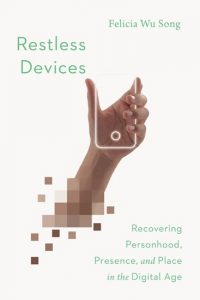Song, Felicia Wu. Restless Devices: Recovering Personhood, Presence, and Place in the Digital Age. Downers Grove: IVP Academic, 2021. pp. 216.
How do we understand personal identity in a time where we do not simply go online, but we live online? Song’s work in Restless Devices examines the question of personal identity in a digital age through the lens of an unapologetic Christian theological anthropology. It takes a supple voice and keen mind to navigate the complexities of digital media to an overwhelmingly uninformed audience about the ethical issues behind technology used every day.
The expertise and tenure of Song’s work here shine in the landscape of the contents of Restless Devices. Anyone studying the ethics of technology understands the complexity of the relationship between the device as a mere instrument and the device as an implement of power. For example, Part 1 (“Being at Altitude; The Terms of Agreement; and The Industrialization of You and Me”) examines how “smart” technologies shape the user through the values laden by the producers of said technology (cf. Jürgen Habermas’ economic thesis). Tech companies use and exploit behavioral psychology and insights from neuroscience to make addictive products without much concern for the ethical and moral outcomes of the user’s relationship. In part 1 (pp. 17–96), Song exposes how Silicon Valley, through tech like social media, has rewired our perceptions of social networks to a series of analytics––will this post attract engagement?
How are users to reconcile personhood, presence, and theological identity in light of the commodification of our social/digital identity? In part 2 (pp. 97–214), Song further examines her thesis that digital technologies often leave us frustrated, exhausted, and isolated, but this disenchantment does not have to be the end of our relationship to technology. Rather than address and engage every issue related to digital technologies, Song goes to the root of the theological and psychological fundamentals of how devices shape us and our appetites for meaning, significance, and security. Instead of taking a Luddite approach to digital technology, Song advises applying a form of the spiritual disciples and practices to the use of our devices, ones that are grounded in spiritual wisdom and community (p. 13).
Song proffers that through understanding the imago Dei as a reflection of humans’ creation of communion with God, we can adequately situate our relation to one another (p. 111). According to Song, we are tempted to subcontract our fellowship with God for connection with people through the device as an implementation of presence. Imperative to Song’s thesis is that we develop counter-liturgies that help us resist this temptation through the practice of spiritual disciplines like a sabbath from our phone or intentional times of disconnection to commune with God’s word and His people. Moreover, Song’s caution about spiritually disruptive devices links to call for ethical due care about the values laden within the technology be created (p. 27). Thus, the scope of her thesis goes beyond cultivating a digital etiquette but to understanding each device as a spiritually shaping instrument. In the words of Song, “we need to recognize that our souls have appetites” (p. 35), and her book is an introduction to the praxis of spiritual disciplines aimed at ensuring the ensouled body is spiritually cultivated and feed.
Restless Devices is a much-needed addition to the literature of theological reflection on media studies. The work is unique in that it proffers a complexity thesis between our devices and spiritual development. Song does not bemoan technology and its usage but rather cautions her readers to consider the theological shaping of the tools we allow into our lives and how they can shape us in both positive and negative ways. I would have liked to have further addressed in Song’s work within the discussion of personhood and fluidity amid embodied and disembodied spaces. This is not a criticism of her work, but I mention this in hopes that she and others will further explore this topic in later additions and publications. While Song addresses personhood and connects it to the imago Dei (“image of God”), a normative reading in Christian theological circles, much more could be said about this topic in our digital age. For example, the incarnation of Jesus is often cited as the model of what we should strive for regarding embodied presence within the local church and our communion with the saints, but this does not mean there is no room for the disembodied presence within digital communities and the powerful connections that can come through digital media. I mention this because there is a temptation to say digital media, and presence through such, is less than embodied physical presence.
Nevertheless, human persons are more than material, and we must be careful to account for the immaterial (i.e., soul) in the life of faith and cultivation of the soul, and there is hope for such because of the incarnation, which goes far beyond mere physical presence. I believe Song would agree with the assessment, and I do not see the absence of this topic as a weakness of her work; in fact, I see Restless Devices as a primer for these conversations as virtual reality and future digital media becomes more integrated into the life of faith and the local church. Song’s work in Restless Devices deserves serious consideration by the academic and lay reader alike. Her work would make a great addition to any Christian ethics course on the undergraduate or graduate level because of its scholarly rigor and telos aimed toward praxis in the local church.
Joshua K. Smith, PhD
North Morton Baptist Church
Morton, MS





